The Former 16th Street For Able-Bodied Pedestrians Only
In 1951 the Plaza Square urban renewal area was defined. More than a decade later, in 1962, six new apartment buildings finally opened on four city blocks that were completely razed, except for two churches, which remained. In addition to removing hundreds of existing buildings, 16th Street was also removed. Both churches and two of the six buildings fronted a new pedestrian-only walkway where 16th Street had been. For over 50 years this has remained mostly unchanged, and, I’ll argue, has been part of the reason behind the decline in the area.
First, some background provided by city staff highlighted in a 1970 report:
In 1951, shortly after the establishment of the Land Clearance for Redevelopment Authority, Plaza Square became a federally-assisted Title I Urban Renewal Project. A bond issue for the project was submitted to voters in 1953 and failed, but was approved later in that year. Execution began in 1954 and rebuilding was done by the Urban Redevelopment Corporation. The Federal Government defrayed two-thirds of the $2,618,000 loss incurred in the write-down and the City bore the remaining third. By developing a park and making street and utility improvements in the area, the City exceeded its required contribution by $114,500. This was applied as credit to the cost of another project at a later date.
The present 16-acre, $20 million Plaza Square Apartment project completed in 1962, contains 1,090 apartments in six multi-story buildings. In addition, it includes two rehabilitated churches with expanded sites, a small park, shopping facilities, and a $2 million office building for the Blue Cross Group Hospital Service. The Plaza Project also has been a significant link in the concept for an East-West Axial Mall extending from Aloe Plaza eastward to the riverfront arch.
In the mid-1960’s, occupancy lagged in the project. In 1966, in an attempt to alleviate this problem, the Bethesda Foundation took title to one of the buildings. The Bethesda Townhouse is now a non-profit residence for senior citizens who lease the dwelling units for life. By 1970, the occupancy rate had reached 88% in the Plaza Square Project.
The success of Plaza Square has had far reaching consequences since it was the first of its kind in the City. One of the most important aspects was the fact that Federally assisted renewal program encouraged private investment in the reconstruction of the City. Its success provided the stimulus for later revitalization projects such as the Civic Center redevelopment.(History of Renewal)
The non-profit building for seniors later became the Blu condos, many of which became rentals or were sold at auction. This post is a look at the pedestrian-only path left after 16th Street was removed. This matters to me personally because I live at 16th & Locust and need to reach the bus stop & city offices at 16th & Market (map).
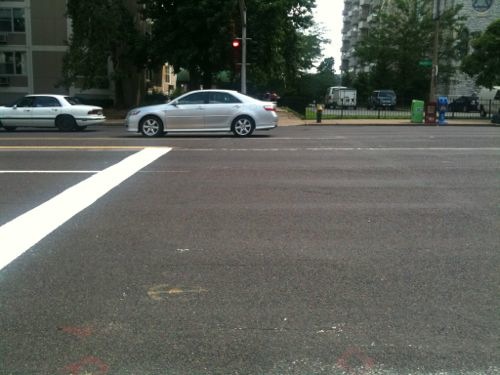
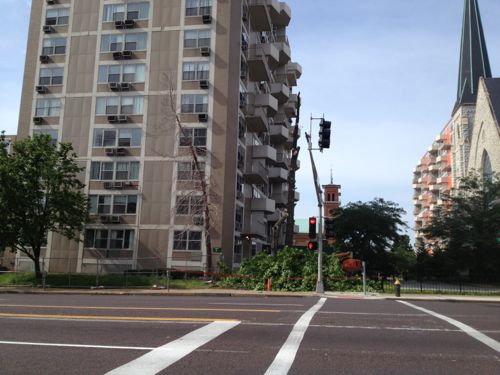
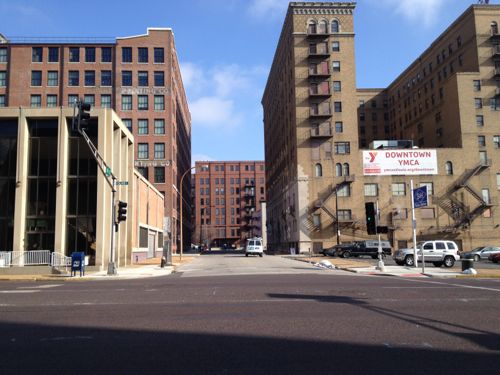
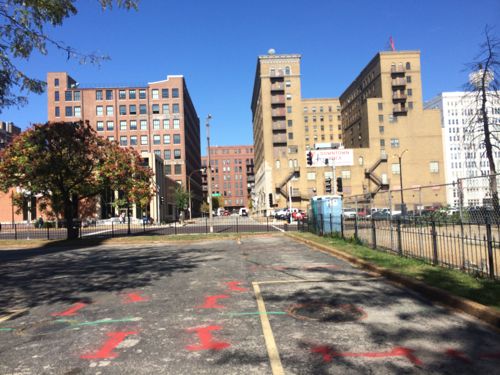
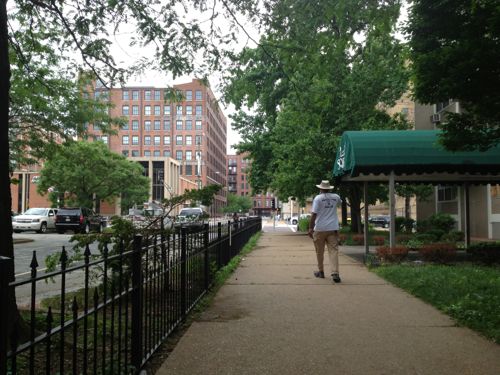
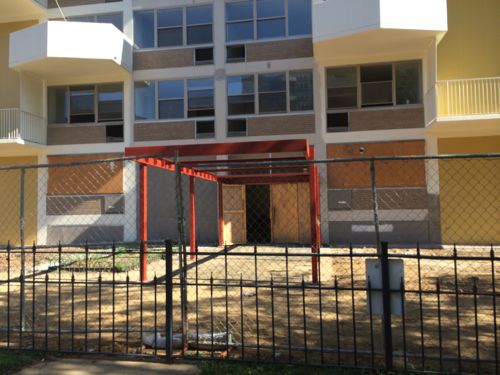
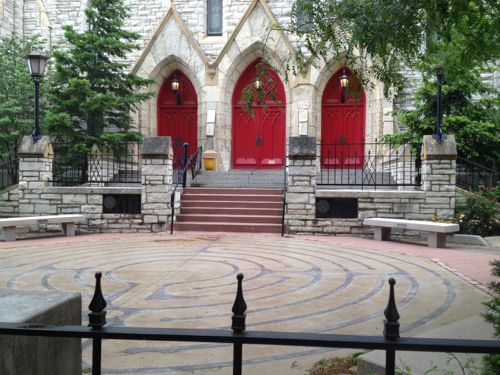
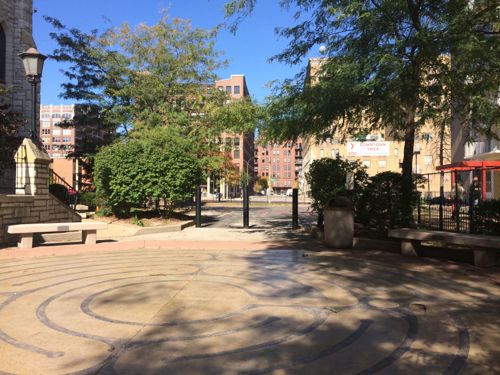
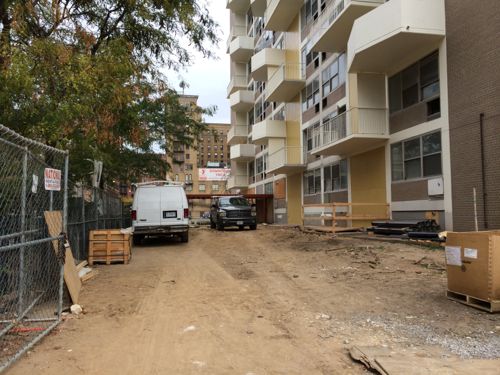
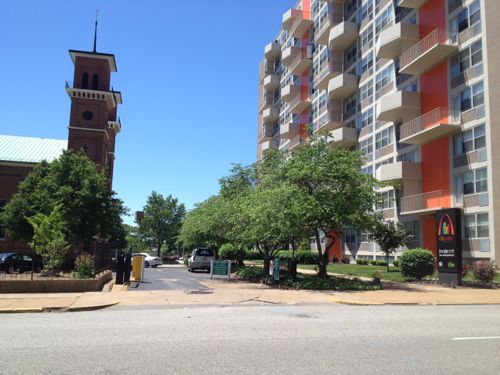
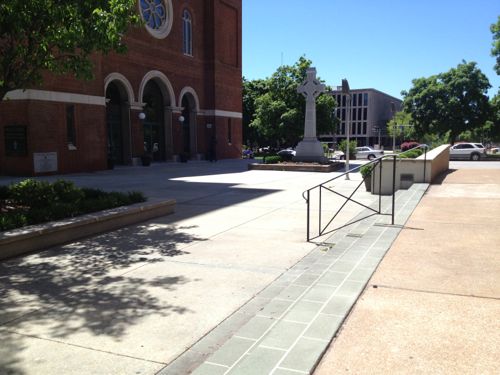
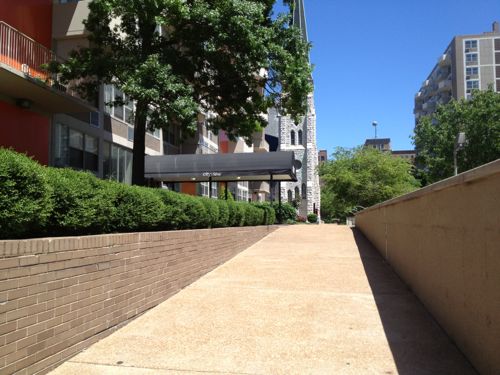
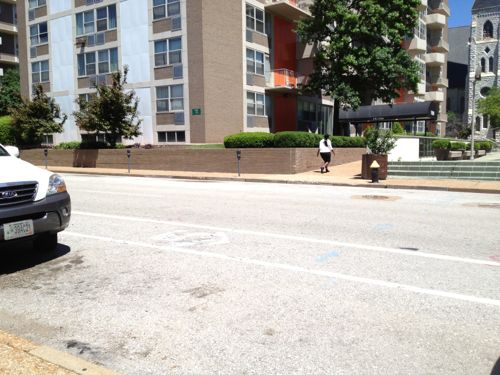
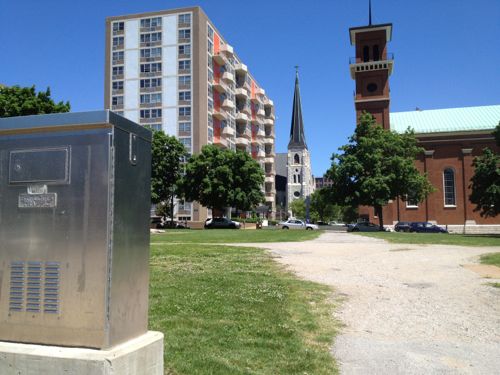
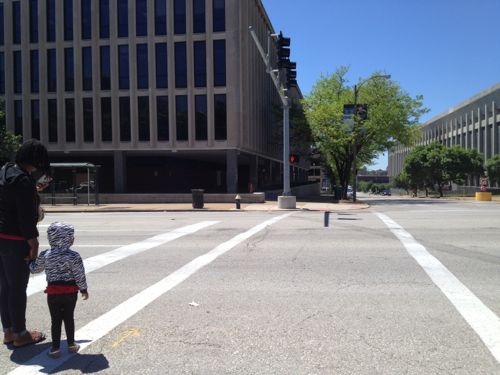
Few people use the former 16th Street walkway, it’s dark, narrow, uneven, and uninviting. I’m forced to take 17th, 15th or 14th instead. Like I said at the opening, I think this dead walkway has been a contributor to problems in the Plaza Square area.When the general public avoids an area and when a church erects a fence to keep out unsavory activity then you know a problem exists — a problem created by the poor design. It performs the opposite of how it was intended, a safe & pleasant car-free zone.
Cars are activity generators. The drivers are eyes on the street, police can drive down streets.
I’d like to see the community look at all options for 16th, including:
- Revising the walkway so it is ADA-compliant.
- Remaking the walkway so it is wider, more inviting and ADA-compliant.
- Reopening 16th Street to traffic, on the same scale as north 14th in Old North. Both were a 60 foot public right-of-way.
- Making Chestnut and Pine two-way streets again
I met with clergy from both churches, neither likes the idea of losing parking or the space in front of each respective entrance. Meanwhile, the owner of four of the six Plaza Square buildings wants to build a parking garage between two of the buildings, without losing the historic designation needed for tax credits (via NextSTL).
— Steve Patterson
Interesting situation. I can see where both “solutions” would have their advocates – eyes on the street/connect the grid versus a fortress mentality – and I’d argue that there are already two “test cases” that (may? may not?) deserve further study – 15th Street versus 16th Street. It’s the adjacent property owner (the churches) versus the nearby property owner (you), and while you may be slightly inconvenienced by being “forced” to travel a whole block further east, it’s not much different than us drivers who can’t use Locust between 4th and Broadway. Life isn’t always fair, and in this case, I’m willing to wait for the current renovations to be completed before saying that the entire two-block stretch is a failure. And the argument that “able-bodied pedestrians” are getting something that you aren’t doesn’t really cut it – that path in the next-to-last photo goes through a park and is not something the city installed or maintains. Sure, the city could put up a fence and block nearly all access, but why should they? It’s a park and it shouldn’t be all paved!
As for the unsavory activity versus design issue, I’d argue that the larger “design” issue is concentrating homeless services in the immediate area. There are plenty of suburban apartment complexes that don’t have the crime issues that seem to occur around here. And while enforcement is obviously one part of the equation (the police can do more than just “drive down streets”), as long as the homeless are concentrated in any one area, they will find nooks and crannies, both public and private, to “claim” as their own.
Signalized intersections for crossing Olive are at 18th, 16th, and 14th. 15th is also lacking ADA ramps in spots.
It would be way easier to add ramps, where needed, on 15th than to “fix” 16th. Yes, we should do both, but we also need to set priorities.
Yes, I can cross Olive at 16th and go a block out of my way. That does nothing to address the problems with this space and how that impacts the churches and apartment buildings.
Unfortunately it appears the city gave away/sold the 16th Street right of way decades ago, so this walkway isn’t public property. However, given the decades of continuous use a public easement may have been created.
Only one homeless service exists in the area I’m talking about, one isn’t a concentration.
And that would be the New Life Evangelistic Center at 1411 Locust, which seems to attract the homeless with issues that “bother” other residents to the point that they’re viewed to be a “problem”, not an asset to the neighborhood: http://www.stltoday.com/news/local/metro/clash-between-st-louis-homeless-shelter-and-downtown-development-comes/article_8b45712c-feb7-5dcf-92ab-22e87ec22ecf.html
Interesting comment. And I agree. It almost seems as if the liberals in the loft community who support Obama and his hopeless socialistic health-care program somehow become a bit more conservative when considering their options for dealing with the “homeless” problems created by the good folks over at New Life.
NLEC is outside the area I’m talking about. I support The Bridge located at Centenary while I work to close NLEC. Both are equal distance from me.
While The Bridge obviously does good work, offering food, clothes, toiletries, emotional support to thousands each year, they appear to ignore the issue of lodging, which NLEC doesn’t ignore. And in the evenings at NLEC, when the troops are gathered together, with each individual protecting his turf and valuables and confined (imprisoned?) in a controlled, highly regulated environment–that’s when conflicts arise and arguments begin among the recruits. And maybe this is why NLEC gets the bad press and is held in lower esteem than The Bridge. When I leave the office late in the evenings around 9 or 10 PM, in the warmer and temperate weather I often see the homeless sleeping on park benches, on exhaust grates, in doorways, on curbs and in alleys. But when the temps drop to the teens and lower, I wonder where these people are going to sleep if NLEC is expelled from the neighborhood?
One of our secretaries owns a loft in Sporting News Building, and she constantly complains about the loud and disorderly patrons at the lounge located immediately to the south of her building. She fails to acknowledge that the bar was there long before she bought her loft. I think many of those residents most upset about NLEC fail to acknowledge the same as it relates to NLEC.
The Bridge has a trained security team to keep the order, prevent fights, etc. Other overnight shelters also manage to keep order. NLEC stands apart from all others.
The buildings near 2020 Washington have had numerous establishments over the years, none lasting too long. She may have bought when a previous business was in place, or when it was vacant. Most buyers don’t know what goes on at 2am until they’ve moved into a new place.
The issue isn’t what happens at/inside the shelters or the bars, it’s what happens outside/away from the locations. It’s about the crowd you attract and how they interact with the other residents in the area. One big reason “responsible” adults like and migrate to suburban areas is most other people share their values and disruptions to the public peace are not tolerated like they are around downtown. They don’t have to “put up with” people who don’t respect private property, who abuse public property and/or don’t respect most people’s need to get up and go to work in the morning. Until those issues are addressed, there will always be conflict – as long as “unsavory activities” are tolerated, they will continue, and neither the Bridge nor NLEC have either the resources or the authority to tell their clients what they should or should not be doing blocks away from their respective facilities. That’s a city responsibility, and the city chooses to tolerate it, to its detriment.
1) The lounge has operated continuously for over 9 years. It operates under a 3 AM license. 2) Probably enough can’t be said about the importance of due diligence–! 3) ……and if NLEC is banished, where will the homeless be allowed to sleep? 4) I am not an advocate of welfare assistance that lasts over 5 or 6 weeks, because I think people will eventually meet levels of expectation if given no other choice…so I personally do not support NLEC. And similarly, in the case of NLEC I sense a large bulk of the liberal loft dwellers are acting much less other-centered than their otherwise liberal and caring declarations would suggest. Too close to home? And maybe they, too, should have done their due diligence–nuclear physicist intelligence level would not have been a prerequisite. (If I buy a house next to a garbage dump, I can’t reasonably anticipate that my living room will smell like a garden filled with gardenias when the windows are raised in the spring!)